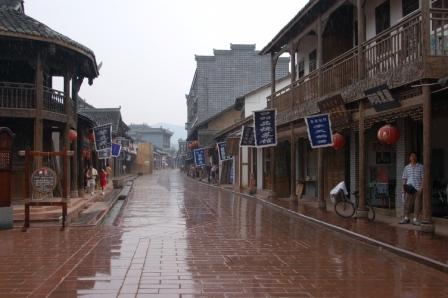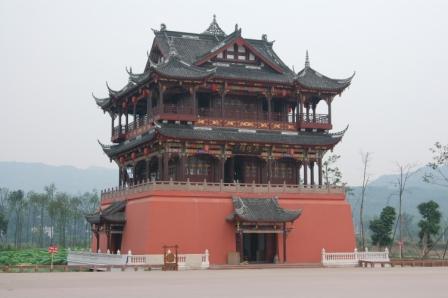Returning to the boat, I want to go to Yuewangtai
Returning to the boat, I want to go to Yuewangtai
stanleyw
I remember when I was in middle school, I learned an article "Remembering My Mother" by Zhu De, which introduced my family's "ancestral home in Shaoguan, Guangdong, and I was a guest. I moved to Ma 'anchang, Yilong County, Sichuan when' Huguang filled Sichuan'." So, I remembered "Huguang fills Sichuan" and learned that there are also Hakka people in Sichuan.
On August 8, I visited Luodai Ancient Town, known as the "No. 1 Hakka Town in Western China". Luodai is located in the eastern suburbs of Chengdu, Sichuan, 18 kilometers away from the urban area of Chengdu.
There are two explanations for the origin of the name "Luodai". One saying is that during the Three Kingdoms period, Liu Chan, the Latter Ruler of Shu, came here to play and saw an octagonal well that was crystal clear and he loved it very much. While viewing it, he accidentally dropped the jade belt he wore into the well, hence the name "Luodai", which later evolved into today's "Luodai", which is still in use today; another saying is that the grassland around Luodai was once herding herds of cattle and sheep, which was rich in leather. At that time, the belt made of leather was called "Luodai".
At present, Luodai has a population of more than 30,000, and more than 90% are Hakka. They still retain the Hakka dialect and follow the Hakka customs. Their ancestors originally lived in the Hakka gathering areas in Guangdong, Jiangxi, and Hubei provinces. They migrated here to take root during the late Ming and early Qing Dynasties when Huguang filled Sichuan.
The ancestors came to this unfamiliar land, and their fellow villagers met from time to time to comfort their homesickness, so they established the guild hall. At present, Luodai still retains the four major halls of Guangdong, Jiangxi, Huguang and northern Sichuan.
Huguang Guild Hall was built with donations from Huguang immigrants in the 11th year of Qianlong of the Qing Dynasty (1746). Dayu is enshrined in the Guild Hall, so there is also a plaque of "Yuwang Palace" at the entrance. According to reports, the patio in the hall has no sewer, but no matter how heavy it rains, even if the street is flooded, the patio will not flow. This is a major miracle of the hall and is passed down because of Dayu's blessing.
Jiangxi Guild Hall was built in the 18th year of Qianlong of the Qing Dynasty (1753) with funds from Jiangxi Hakka immigrants. There is a "blessing tree" in the clubhouse, and another big tree with luxuriant leaves and branches grows from the head of a dead tree. There is a square at the entrance of the clubhouse, and next to the square is the newly built Wufeng Building. There is also a stage on the square with a huge background painting of the "2006 Sixth Hakka Water Dragon Festival in Luodai Ancient Town, Chengdu".
The Guangdong Guild Hall is a landmark building in Luodai, also known as the "Nanhua Palace". It was built with funds from Guangdong Hakka people in the 11th year of Qianlong of the Qing Dynasty (1746). It is by far one of the best preserved and maintained halls in Sichuan Province and even the whole country. It is the most majestic Guangdong Guild Hall surviving in the Qing Dynasty. The Guild Hall's wind and wall walls are majestic, and its architectural style is unique in Sichuan. The Guild Hall also has many exquisite stone carvings and embossed.
Entering the main hall, there is an antique couplet hanging inside, which reads,"Bayezi smoke tastes the local flavor of Western Shu, and puts Hakka dialect to warm the ancient pronunciation of the Central Plains." This not only shows the harmony between the culture of the homeland and the culture of Bashu, but also reflects the ancestral motto of "It is better to sell the ancestral fields than to lose the Hakka language." A stone tablet of the "Hakka Soul" stands in the inner hall, and the couplets on the pillar reveal the Hakka people's homesickness: "The clouds and rivers are vast, and they have lived in the Bazi State for a long time in other places; they are passing through the countryside, and they want to board the Yuewang Terrace when they return home."
Yuewangtai, also known as the "Yuewangtai", was built by Zhao Tuo, King of Nanyue during the Western Han Dynasty. In today's northeast of Yuexiu Mountain in Guangzhou, Guangdong, only its old site remains. Song Ziwen, a poet of the Tang Dynasty, wrote the poem "On the river, climb the mountain and look at it several times."
The original site of the North Sichuan Guild Hall was Wolongqiao Street, Chengdu. It was built during the Tongzhi period of the Qing Dynasty. Due to the need for the renovation of the old city of Chengdu, the original appearance of the museum was moved to Luodai.
Chengdu people like to "soak in teahouses". Tea houses have been opened in these clubs in Luodai. People live a leisurely time here. This is also a good way to "use a museum to support a museum". Hakka sad powder is sold in Guangdong Guild Hall. It is said that after Hakka people came to Sichuan, every time they made jelly for their hometown, they would arouse infinite sadness for their hometown, so they got the name. However, although I still have snot and tears when I eat it now, it is no longer because of nostalgia and sadness, but because of the pepper.
Guangdong, Jiangxi, and Huguang Guild Halls are all located on the old street of Luodai. At one end of the old street is the gate of "Zhenzichang", which was renamed "Zhenzichang" during the Qing Dynasty due to the large number of people attending fairs. There is a Sifang Tower at the other end of the old street. It is said that people who travel from Chengdu to Jianyang to Chongqing have to stay here overnight and climb the Sifang Tower and ring the bells the next morning to ensure a safe journey.
There is a character library tower on the old street, and the dragon brick carvings on the tower are lifelike. It is a Hakka tradition to cultivate, read and inherit the family. Hakka people attach great importance to reading and writing, so they cherish the word paper. All paper with words must be collected and burned. The character library tower is used for burning the word paper.
Walking along the old street, you will find ancient buildings in the late Qing Dynasty and Republic of China styles. There are mid-flower decorations on the roofs of many buildings. The roof decorations seen in other places are basically brick carvings and pottery carvings, but the flowers here are floral decorations made of ordinary tiles, which is quite thoughtful.
There are canals built next to the old street. Along the old street, many stone water tanks are placed. They are basically one meter long, and some are two meters long. They are all carved out of a large stone. There are exquisite embossed patterns on the outer walls of the water tanks, either flowers, or figures, or dragons. These water tanks are usually planted with some aquatic plants. At the Hakka Water Dragon Festival, they are washed and filled with clear water for splashing water.
The Hakka Water Dragon Festival is similar to the Water Splashing Festival. It was originally an annual event. Now, in order to create "the world's Luo Dai and the eternal Hakka", the Hakka Water Dragon Festival is held every Saturday and Sunday from the end of July to the end of August this year. Unfortunately, the day I went there was not Saturday or Sunday, and I couldn't appreciate the Han Hakka Water-Splashing Festival. It must have been water droplets flying and laughter overflowing.
With Luodai as the center, about 500,000 Hakka people live in more than a dozen surrounding towns. There are about 3 million Hakka people in Sichuan, mainly living in the Dongshan area of Chengdu in western Sichuan. They are called the "Dongshan Hakka". The main venue of the 20th World Hakka Patriotic Conference in 2005 was in Luodai.
I am a Hakka child. I didn't expect that there is still a strong Hakka culture preserved and being carried forward in the land of Bashu separated by the Pass Mountains. I still feel cordial here. The return to Hakka traditional culture expresses the Hakka people's attachment to their hometown, and its intensity is proportional to the distance from leaving home.
Strategy:
Transportation: At Chengdu Bus Wuguiqiao Bus Station (do not walk to the adjacent Wuguiqiao Chengdu Bus Station), take 219 to Luodai (terminal), 3 yuan each way, no air conditioning. About 50 minutes drive.
Tickets: No tickets are required to enter the ancient town or the guild hall. Some clubs have exhibitions and need to buy tickets, but I didn't visit them.
Food: The meat tofu pudding on the old street is 6 yuan per person, and the tofu pudding and white rice are added to you. After eating, I found that there are many restaurants on the old street where I can order.
Popularity: The day I go is not Saturday or Sunday, and there are very few tourists.
(Old Street)
(Wufeng Building)
(Huguang Guild Hall)
(Guangdong Guild Hall)
Previous Article:Chengdu Chengdu [Part 1]
Next Article:And head west (9) A weir through the ages




